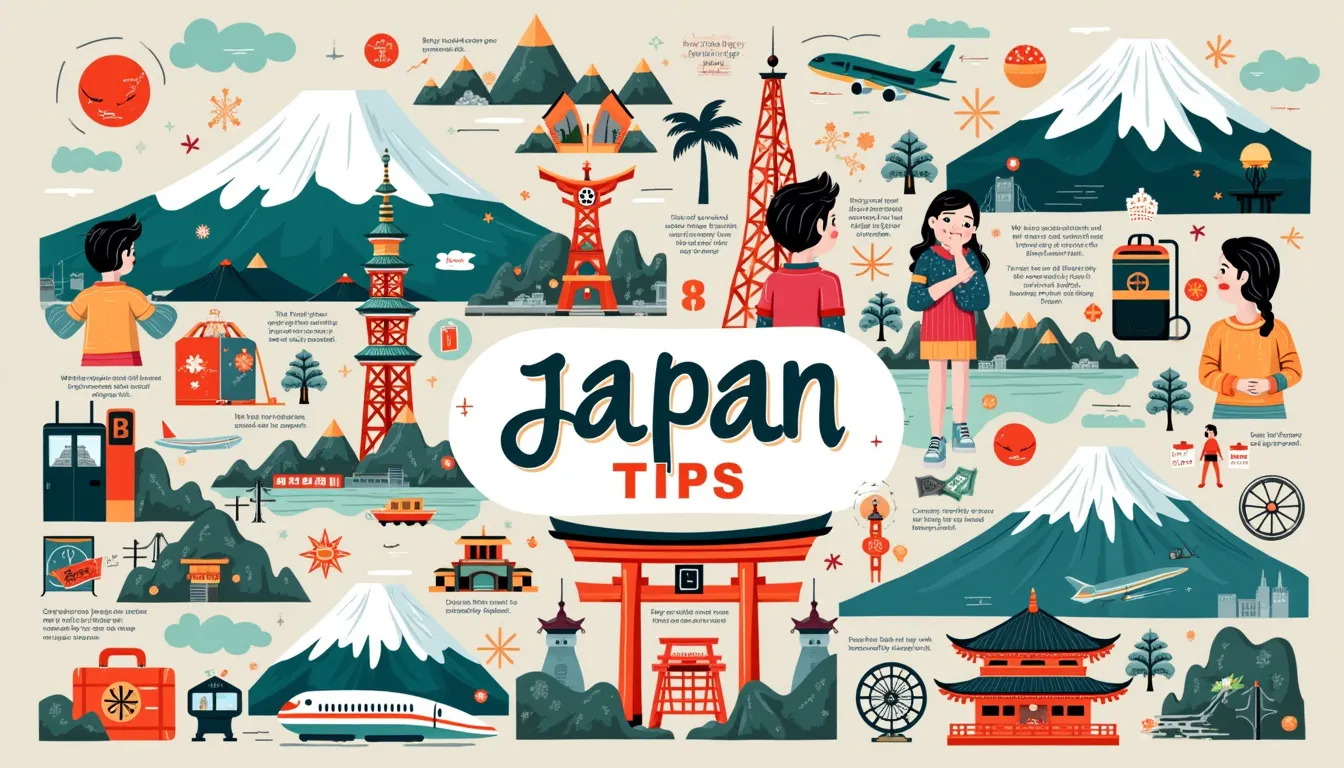Traveling to Japan offers a captivating blend of age-old traditions and cutting-edge modernity, promising an unforgettable experience for those who visit. Before embarking on this incredible journey, it’s crucial to equip yourself with essential knowledge to navigate the cultural and logistical nuances of the destination. Understanding what to know before traveling to Japan can significantly enhance your experience, allowing you to interact respectfully and effortlessly with the local customs and environment. Delve into the profound world of Japanese etiquette, where practices such as bowing, handling chopsticks deftly, and maintaining decorum in public spaces are integral aspects of everyday life. Additionally, arming yourself with a handful of polite Japanese expressions and phrases can open doors and foster warm exchanges with locals, enriching your travel experience. Beyond cultural acclimatization, thorough travel preparations set the stage for a seamless adventure. From understanding visa requirements and gathering necessary documentation to packing the right seasonal clothing and electronics, knowing the essentials can help prevent common travel hurdles. Join us as we explore these key considerations to ensure your trip to Japan is both memorable and respectful.
Understanding Cultural Etiquette: What to Know Before Traveling to Japan
Overview of Japanese Customs and Manners
One of the most critical aspects of preparing for your journey to Japan is understanding the local customs and manners. Japanese society places a high value on respect and politeness, and being aware of these cultural norms is essential. Let’s explore three crucial areas: bowing, handling chopsticks, and public behavior.
Bowing
Bowing is a fundamental aspect of Japanese culture that signifies respect and greeting. When meeting someone for the first time or thanking them, a slight bow from the waist is common. The depth of the bow can indicate the level of respect. A deeper bow suggests more reverence, while a simple nod is often sufficient for casual encounters. It is important to note that although western-style handshakes are becoming more common in Japan, combining a handshake with a slight bow can make a positive impression.
Handling Chopsticks
Proper use of chopsticks is another critical piece of cultural etiquette to master before your trip. Here are a few essential tips:
- Avoid Crossed Chopsticks: Placing your chopsticks in a crossed position is considered bad manners.
- Don’t Stick Chopsticks into Food: Sticking your chopsticks upright into a bowl of rice is a funeral ritual in Japan and should be avoided.
- Passing Food: Don’t pass food using chopsticks from your set to another’s; this also mimics funeral customs.
- Resting Chopsticks: When not using your chopsticks, place them on the holder provided, not directly on the table.
Understanding and practicing these simple principles will ensure you avoid any unintended cultural faux pas.
Public Behavior
Japanese society values punctuality, orderliness, and politeness in public settings. Here are a few guidelines to help you navigate these social expectations:
- Noise Levels: Keep your voice low and be mindful of your noise level, especially in public transportation settings like trains and buses.
- Queuing: Stand in line patiently; pushing or cutting in line is unacceptable.
- Walking Etiquette: Walk on the left side of sidewalks and escalators, leaving the right side for those in a hurry.
- Cleanliness: Maintain cleanliness by using designated areas for trash disposal. Japan takes clean public spaces seriously.
Important Phrasing and Polite Expressions: Basic Japanese Phrases Every Traveler Should Know
Learning a few basic Japanese phrases goes a long way in demonstrating your respect for the culture and people. While many Japanese people speak some English, especially in tourist areas, using Japanese phrases can enhance your travel experience. Here are essential phrases you should know:
Greetings
- Hello: こんにちは (Konnichiwa)
- Good Morning: おはようございます (Ohayou gozaimasu)
- Good Evening: こんばんは (Konbanwa)
Expressions of Thanks and Apologies
- Thank You: ありがとう (Arigatou)
- Thank You Very Much: ありがとうございます (Arigatou gozaimasu)
- Sorry/Excuse Me: すみません (Sumimasen)
- Deep Apology: ごめんなさい (Gomen nasai)
Basic Inquiries and Requests
- Yes: はい (Hai)
- No: いいえ (Iie)
- Please: お願いします (Onegaishimasu)
- How Much?: いくらですか (Ikura desu ka?)
- Where is the Bathroom?: トイレはどこですか (Toire wa doko desu ka?)
Having these phrases at your disposal can help you navigate your experiences more smoothly. Additionally, a respectful demeanor and willingness to use local language, even if minimally, can significantly enhance your interactions.

Travel Preparations: What to Know Before Traveling to Japan
Visa Requirements and Necessary Documentation: Ensuring a Smooth Entry
Navigating the visa requirements for Japan can be straightforward, provided you are well-informed. Depending on your nationality, you may be eligible for a visa exemption, which allows visitors from specific countries to stay in Japan for a specified duration without a visa. For example, citizens from the United States, Canada, the United Kingdom, and Australia can enter Japan as tourists for up to 90 days without a visa. However, always verify the most current requirements with your local Japanese embassy or consulate, as visa policies can change.
If a visa is required, begin the application process well in advance. Typical requirements include a completed visa application form, a recent passport-sized photograph, a valid passport with sufficient blank pages, proof of financial stability, and an itinerary detailing your stay in Japan. Additionally, you may need to present a letter of invitation if staying with someone or proof of round-trip airfare. Ensuring that you have all necessary documents and fulfilling all criteria will help you avoid any potential delays at immigration.
Japanese immigration officers are known for their thoroughness. Upon arrival, you’ll be required to complete a landing card and go through fingerprinting and photographing as part of the entry process. Ensure you have your hotel reservation details handy, as you might be asked to provide this information. Being prepared and having all necessary documentation ready will enable a smooth and stress-free entry into Japan.
Packing Essentials: Seasonal Clothing, Electronics, and Other Must-Haves for Your Trip
Proper packing is essential to ensure a comfortable and enjoyable trip to Japan. When considering what to know before traveling to Japan, recognizing the seasonal variations in climate can greatly influence your packing decisions. Japan experiences four distinct seasons: spring (March to May), summer (June to August), autumn (September to November), and winter (December to February).
If you’re traveling in spring or autumn, layers are key. These seasons tend to be temperate but can fluctuate. Pack light sweaters, long-sleeved shirts, and a medium-weight jacket. Spring travelers, in particular, should pack for the cherry blossom season, which can sometimes mean cool breezes. Summers in Japan, especially in cities like Tokyo and Osaka, can be hot and humid. Lightweight, breathable clothing is ideal, along with sun protection like hats and sunscreen. Conversely, winters can be quite cold, particularly in northern regions like Hokkaido. Warm clothing, including thermal layers, a heavy coat, gloves, and a hat, are essential for winter travel.
Beyond clothing, think about the electronics you’ll need. Japan uses a 100-volt electrical system, and its outlets accept plug types A and B (two flat parallel pins). If your devices are not compatible, an adapter and possibly a voltage converter will be necessary. Japan is known for its electronic stores, but prices can be high, so it’s better to be prepared. Additionally, having a portable Wi-Fi device or an international SIM card can be incredibly useful. While Japan has good Wi-Fi coverage in urban areas, rural areas might have limited connectivity.
Other essential items to consider include medication and toiletries. Many over-the-counter medications available in your home country may require a prescription in Japan, so bring enough for your entire trip. Basic toiletries are widely available, but favorite brands might not be. Additionally, consider bringing a small medical kit including band-aids, antiseptic wipes, and pain relievers.
It’s also wise to pack a reusable water bottle, as Japan has numerous public water fountains and vending machines. Comfortable footwear is another must-have since you’ll likely be doing a lot of walking, whether exploring bustling cities or tranquil temples. A compact, foldable umbrella can be a lifesaver during sudden rain showers, especially considering Japan’s rainy season in June and July.
Lastly, preparation involves not just your physical belongings but also financial readiness. Japan is predominantly a cash-based society, despite its high-tech reputation. While credit cards are accepted in many places, small businesses and rural areas might only take cash. Ensure you have enough Japanese yen on hand upon arrival, and familiarize yourself with the location of ATMs that accept international cards. Many convenience stores have reliable ATMs with English language options, making it easy to withdraw cash as needed.
Traveling to Japan offers an incredible experience full of rich cultural heritage, delectable cuisine, and advanced technology interwoven with traditional customs. Understanding cultural etiquette is paramount to ensure a respectful and enjoyable visit. Familiarizing yourself with practices such as bowing, the proper handling of chopsticks, and maintaining decorum in public spaces will help you navigate social interactions with ease. Additionally, arming yourself with basic Japanese phrases will not only facilitate smoother communication but also demonstrate your respect for the local culture.
Moreover, thorough travel preparations are essential to make your journey as streamlined as possible. Obtaining the correct visa and gathering necessary documentation will prevent any complications upon your arrival. Equally important is packing appropriately, considering Japan’s varied seasons and the specific items you may need, such as suitable clothing and compatible electronics.
In conclusion, a successful trip to Japan hinges on a blend of respect for cultural practices and meticulous planning. By educating yourself on Japanese customs and ensuring you have all necessary preparations in place, you will be well-equipped for an unforgettable adventure.







